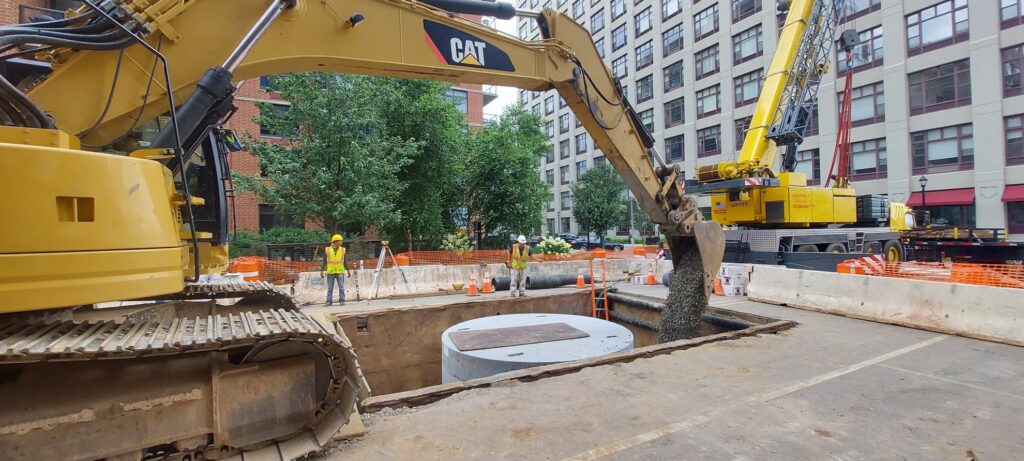People Spotlight: Meet Karen Appell
Our People Spotlight series gives you an inside look at our technical experts around the world. This week, we are highlighting a climate adaptation lead from our Water business line in the U.S. East and LATAM region and providing an insight into their inspiration and work.
Karen Appell, PE, manages large, multidisciplinary teams in developing strategic solutions for complex, multipurpose infrastructure projects in urban areas. She is currently the Project Manager for Rebuild By Design – Hudson River in New Jersey and the Climate Adaptation Lead for NY Metro Water. With a unique educational background and focus on ecosystem restoration in the beginning of her career, plus over 20 years of experience collaborating across the engineering, ecology and landscape architecture fields, Karen specializes in implementing a comprehensive approach in integrating resilient and sustainable elements for both coastal and inland projects. She also leads AECOM’s Extreme Weather Initiative for the region.
Tell us about what inspired you to join the industry
Growing up in Ohio, I spent five weeks each summer (from elementary through high school) at a four-fold living camp, including one summer backpacking 80 miles and biking 500 miles in Michigan and Canada and another summer biking 1150 miles from Michigan to New Hampshire, all without support vehicles! Living in the outdoor elements with female counselors with strong environmental convictions (thank goodness for those 1980s 20-something “granola girls”) is where my love for outdoor adventure was born.
As I became a teenager, I gravitated towards and adopted a sense of responsibility to the Earth and our natural environment. Later, at Cornell University, I discovered a newly accredited engineering program called Agricultural & Biological Engineering (ABEN), a joint program between the Engineering and Agricultural and Life Sciences Colleges. After taking all the requisite engineering courses, I was able to focus on subjects like topography, solid waste engineering, natural resources, environmental economics and wetland engineering. When I graduated, I spent almost two years in the field doing wetland and stream assessments and delineations, and then, with an understanding for how natural systems function, I worked on wetland restoration designs. Moving to NYC to reunite with many of my college friends led me to my second job, where I focused on the field of ecological restoration, designing restored wetlands and streams.
What is your favorite AECOM project that you’ve worked on and why?
It would probably be the project I currently manage, Rebuild By Design – Hudson River (RBDH) Project, in Hoboken, Weehawken, and Jersey City, New Jersey, where we’re designing and constructing almost two miles of floodwall through a very dense, urban community. There are so many moving parts and I literally learn something new each day. Over 300 people from over 20 disciplines have worked on the project since it started in the summer of 2017, including engineers, architects, landscape architects and scientists from offices throughout the U.S. and Canada.
This is a career-changing project for me in a lot of ways. It’s large for a water-focused infrastructure project and there are complicated schedule, design and stakeholder factors in play due to the funding source, existing infrastructure and community needs. It’s very visible and is the first Superstorm Sandy-funded project to go to construction, which will bring even more attention.
For me personally, to be able to manage a project like this, one that will have an actual measurable and visible impact in providing a more resilient future for the community, all with an A++ design team where everyone is extremely dedicated and talented, feels quite special.
Tell us a story of how your work positively impacted the community.
My first reaction is that it’s not a single story. Resiliency and sustainability are rooted in ecological engineering, which is where I started in the industry. In a sense, where things are now, I feel like I am one of the “Resiliency OGs.” I always think about all the buzz words we focused on — environmentally-friendly, green, ecological, sustainable and resilient — and now net zero and carbon neutral are coming to the forefront as well. But to me, positive impact has always meant being involved in projects that shepherd the health of the natural environment (and I know this sounds cheesy but it’s true). One thing I’ve noticed lately as I’ve become more involved with business development and strategy is that resiliency is not just about the environment or climate change. It’s also about our projects and our clients considering things like technology, infrastructure, community interaction and finances. I’ve been enjoying the challenge of integrating all these competing priorities.
Share a piece of career advice
If you can get out into the field or on a construction site, do it! It’s a gift from the consulting universe! Yes, you may have to deal with variable weather conditions or atypical work hours, but seeing and understanding how systems function, how contractors approach things onsite and how things work in reality, is an invaluable experience.










